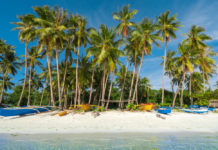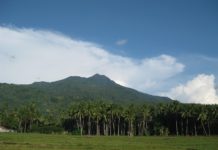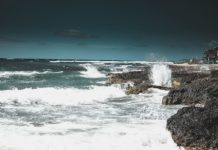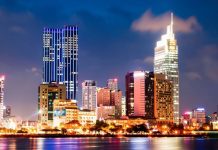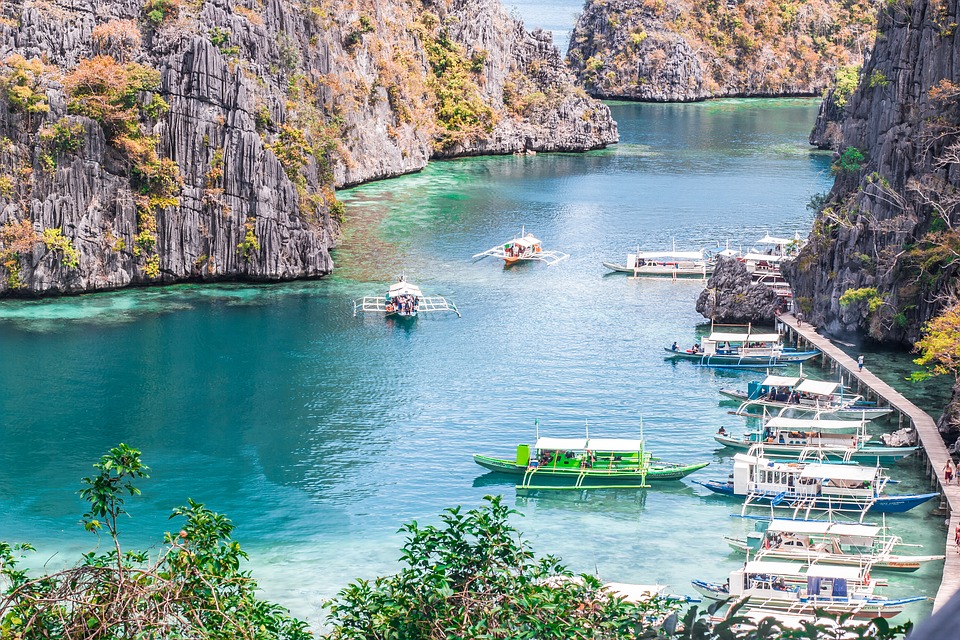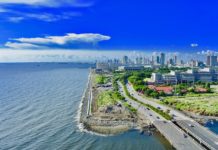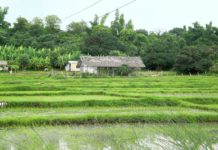Thinking of going to the Philippines?
We’re definitely all for it! There’s awesome beaches, a laid-back, friendly culture, rice terraces to see, mountains, delicious food and the chance to island-hop around some pretty beautiful gems in the sea.
It definitely is not all paradise though… some parts of the Philippines are actually pretty dangerous to visit. Typhoons can hit the country badly and there are also earthquakes to take into consideration.
We’ve created this safety guide for the Philippines to help you plan your trip accordingly – and to give you all the tips and information you need so you can travel smoothly.
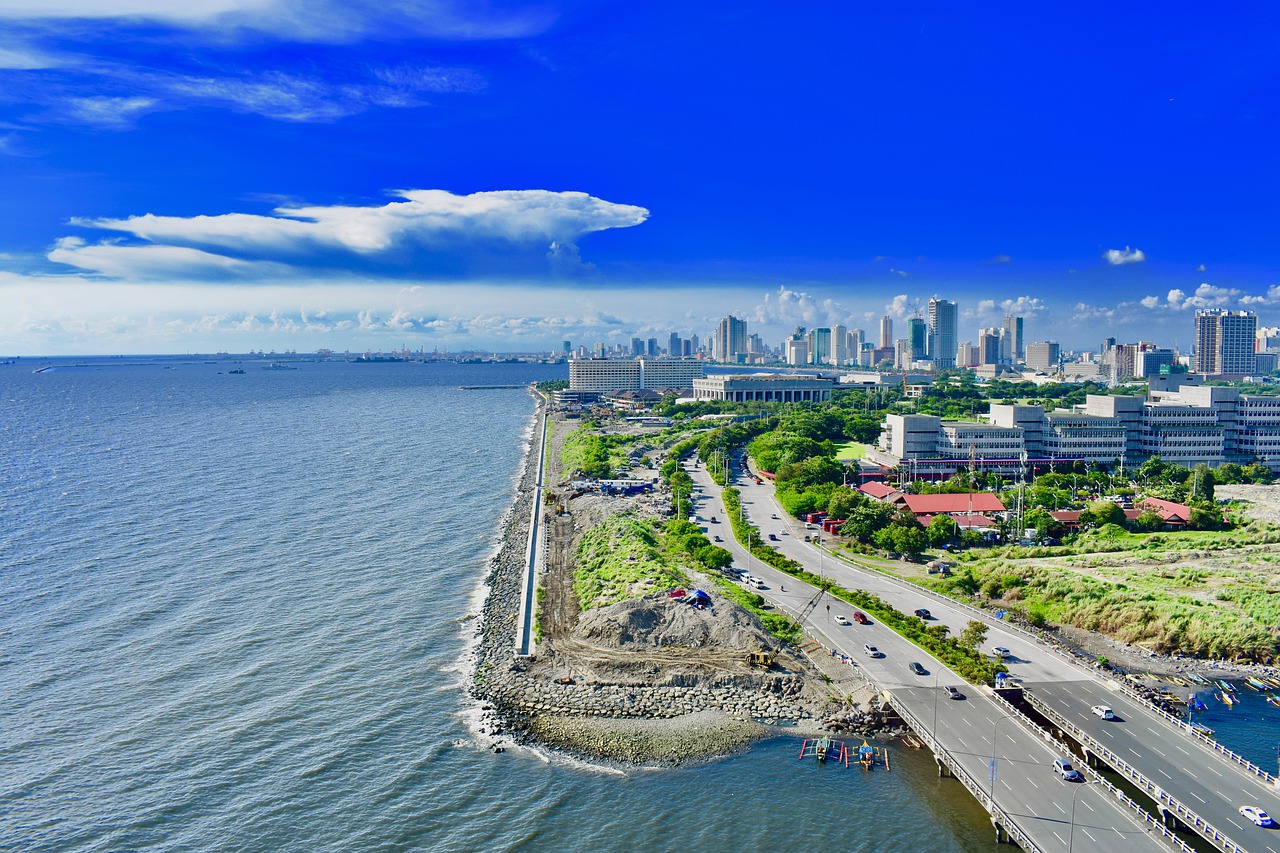
How Safe is the Philippines? (Our take)
Despite what you might have read online, and despite some actual apparent dangers in the Philippines, it’s actually pretty safe.
When you compare the Philippines to the rest of Southeast Asia, it’s as safe as any other country in the region.
There is definitely a fear factor at play when it comes to media reports and government warnings. However, most of those red flags are easily avoidable when travelling around this beautiful island nation.
A lot of people speak English. The vibe is relaxed. On the whole, people are friendly and happy to help tourists.
However, those government warnings are there for a reason. There is violence in certain regions of relatively remote provinces.
There is also the chance of volcanic activity and earthquakes, typhoons (the Philippines gets about 20 a year), and some safety standards being less than what a Western or European traveller might be used to.
Is the Philippines Safe to Visit? (The facts.)

There are many statistics floating around out there – the good, the bad, and the ugly.
First, let’s have a look at how many people go to the Philippines.
- The tourism industry is very important to the Philippines. In 2015 it contributed 10.6% to its GDP.
- In the same year, the tourism industry employed almost 5 million Filipinos!
- In 2017, tourist numbers peaked at 6,620,908!
- The Philippines was also ranked 79th out of 136 countries listed on the Travel and Tourism Competitiveness Report (2017).
As you can see, a lot of people visit the Philippines – but the country still wants more, which is why it’s in the government’s best interest to keep visitors safe.
Now, let’s take a look at crime statistics, one of the most-searched questions from potential visitors.
- The Philippines once had the highest murder rate in all of Southeast Asia in 2013, at 9.84 homicides per 100,000 people.
- Since President Duterte was elected, there have been over 7,000 extrajudicial killings.
- In the 2019 Global Peace Index, ranking 163 countries worldwide based on their safety and peace, the Philippines came in at 134 – just below Eritrea and above Burundi.
- The report also said the Philippines has a higher amount of multiple climate hazards than other countries at risk, like Japan, Bangladesh and Myanmar.
- Last year (2019) the Philippines declared a “national dengue epidemic” with a 98% increase from the year before. Get your shots!
Stacked up, these stats may look scary, but the vast majority of visitors aren’t impacted by these threats, and are able to visit the country worry-free.
Is it Safe to Visit the Philippines Right Now?
There are some things that do threaten safety in the Philippines at certain times of the year. There are also certain areas of the country that are definitely best avoided at present – and have been for some time.
- Taal Volcano, located 60 kilometres south of Manila, has seen increased volcanic activity since the January 12, 2020. However, on January 26, the Philippines’ authorities lowered the alert level, meaning the recommended evacuation zone now extends for 7 kilometres around the volcano; it is not advised to go anywhere near it.
- The Philippines experiences around 20 typhoons a year. These occur roughly between June and September. High winds and heavy downpours means flooding of rivers and roads, dangerous seas, and structural damage to buildings.
- The Philippines is in an earthquake zone. Though the chance of a severe earthquake happening while you’re here is probably quite low, they can occur – the most recent was in April 2019.
- Central Mindanao and the Sulu Archipelago are not safe places to travel. It is not advised to travel there unless it is essential. Insurgent groups have been clashing with Philippines military here for years and the area is not set up for tourism. Best avoided.
It is important to know what is going on in the Philippines at the time you plan to visit. Research is key!
The Philippines Travel Insurance
Have you sorted your Travel Insurance? Even if you’re going on a short trip, it is always a good idea to travel with insurance. Have fun while visiting Philippines, but take it from someone who has racked up $1000’s on insurance claims, it is a good idea to get it sorted before you leave home!
The unthinkable can and does happen so it is better to be insured!
We personally use World Nomads to insure all of our adventures. Why not get a quote for yourself?
Do be sure to read the terms and conditions to make sure they are the right provider for your trip.
To find out why we recommend World Nomads, check out our World Nomads Insurance review.
If you want to shop around a little, then read up on competing companies and what they can offer. There are lots of insurances out there, so don’t feel limited.
18 Top Safety Tips for Traveling to the Philippines

With all those scary statistics and seasonal (as well as regional) hazards, the Philippines may not seem as safe as you thought it was.
However, plenty of people travel here and have an amazing time!
We want to help you do the same, so here are our top safety tips for the Philippines to keep in mind.
- Be aware of your surroundings. There is a high level of street crime and robbery in cities, so being alert will help you avoid becoming a victim.
- Leave expensive accessories at home. That’s not just jewellery, but even walking around with smartphone in hand could attract potential thieves.
- Only travel with reputable taxi companies. Using unlicensed taxis can mean you get ripped off – or worse.
- Be vigilant on public transport. Thefts and assaults can occur in cities like Cebu and Metro Manila, so take care.
- Make copies of important travel paperwork. This includes your passport. Exploring cities with the real thing in your backpack is risky.
- Pay attention to weather warnings. Adverse weather can greatly affect travel plans and leave you stranded.
- Be prepared in case of typhoons. Stock up on bottles of water and food that can last – just in case.
- Know what to do in an earthquake situations. When earthquakes hit, it all happens quickly. You should be aware of exits and places where you can ride it out.
- Steer clear of drugs. Penalties are harsh, Philippines’ prisons are not nice and the judicial system is slow.
- Watch your drinks. Drink spiking can occur, so it is best to keep your drink in sight at all times and avoid accepting drinks from strangers.
- Only use ATMs in safe places. Day or night, the ATM should be in a busy, well lit area and preferably inside.
- Don’t resist if somebody tries to mug you. It is not all that common, but if somebody wants your things – hand them over. Robberies can be violent.
- Take care when swimming off the coast. Ask locals if it is safe to swim or read up on beaches where swimming is safe.
- Keep a cool head. Things won’t always go your way in the Philippines, but it’s not cool to show your frustration or get angry – it could provoke an unnecessarily heated situation.
- Stay away from protests. They may turn ugly and it’s not a good idea to get involved.
- Don’t trust everybody. Kidnappings by gangs who may get someone to pose as a “friendly local” to gain your trust, though not common, can happen.
- Avoid giving money to children. They are often being exploited by criminal gangs and the money almost certainly won’t go to them. It’s a personal choice at the end of the day, but it is advised to find charities where your aid will be more useful.
- Don’t leave valuables unattended. Phones on tables or bags on chairs are easy pickings for opportunistic thieves.
Hopefully our top safety tips for the Philippines will help your trip go smoothly.
You may not have to use any of this know-how, but it’s important to know that bad things can happen.
The key thing to take away here is to be aware of what’s going on around you!
Keeping your money safe in Philippines
The Philippines may be a cool place to visit but, like many places that tourists visit, there is an issue of petty theft. Nobody likes losing their money – and it’s even worse if someone steals it.
So what do you do?
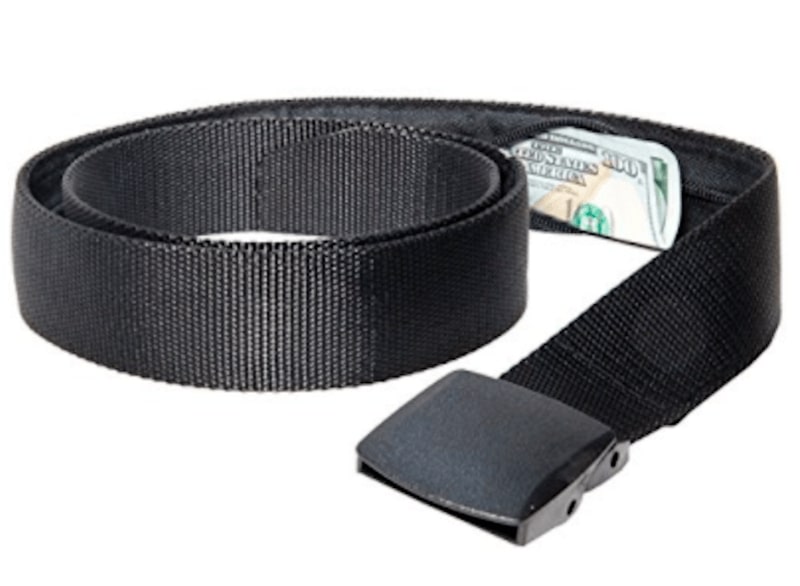
The solution is a simple money belt.
Not all the money belts you can find out there are great, however.
If you want our recommendation, that would be the Active Roots Security Belt!
This is a great way to keep your money safe. Unlike other money belts, which you sometimes have to wear under your clothes (and they look kind of obvious), this looks and acts like a regular belt.
Except there is the subtle addition of a zipper pocket where you can keep the money you need for the day.
It is a simple way to keep you losing any money at all. No pickpocket will suspect an everyday-looking belt!
Is the Philippines safe to travel alone?

Solo travel is great – that is no less true in the Philippines.
There is plenty to see and do across the island nation if you decide to travel here by yourself. It’s a top Southeast Asian backpacking destination for solo travellers.
When it comes to staying safe in the Philippines while travelling solo, we have some pointers!
- Don’t be afraid to ask for help. Filipinos (and filipinas!) are very friendly and helpful people, in general, so you should never feel too isolated or alone.
- Keep in touch with people. Call your relatives and friends back home if you do feel lonely. It’s perfectly normal to feel weird when you’re travelling by yourself, so don’t feel bad calling people for a chat.
- Book accommodation you feel comfortable in. Following hotels, there are hostels and guesthouses for you to stay pretty cheaply in the Philippines. Just make sure that other solo travellers have enjoyed staying there and that it is in a safe location.
- Meet up with other travellers. Either at social hostels, through couchsurfing, travel groups on Facebook, or Philippines-based socialising events. It can really enrich your trip!
- Book a tour. This doesn’t mean you are “failing” at solo travel. Tours can actually be an fun, social and informative way to get to know a country. As always, go with well reviewed guides and companies.
- Get local tips. Staff at your accommodation and locals you may meet will know the area better than you – and your guidebook! Ask for places to eat, cool hangouts, hidden gems and even neighbourhoods you should avoid.
- Travel light. Walking around with a massive, heavy backpack or multiple bags can make you a target. It is also really uncomfortable.
If you are thinking of doing so, you should definitely travel the Philippines by yourself. Even locals like to get out and explore their own country from time to time!
Keep a level head, travel at your own pace and remember to check in once in a while back home. You will almost certainly have an amazing adventure.
Is the Philippines safe for solo female travellers?

If you are a solo female traveller looking to tackle your next destination, the Philippines could be the one for you!
Generally, it is safe place for women to visit by themselves. Like a lot of Southeast Asia, female travellers won’t have too many problems.
That said, there are some safety tips specific to female travellers in the Philippines that you should bear in mind.
- Dress to fit in. The Philippines in a big place and the clothes that don’t stand out in Metro Manila, may stand out in a more rural setting. Bring modest clothes, just in case.
- Avoid deserted, poorly lit areas of towns and cities. These aren’t safe places to walk by yourself.
- Follow your gut feeling. When it comes to safety, always trust your gut! Don’t be afraid to remove yourself from a situation you aren’t comfortable in.
- Don’t drink too much. Going out to party is all good, but too many drinks may put you at risk – not only of assault, but simply being lost on the way back to your accommodation.
- Research, research, research. Finding the best places to stay in the Philippines as a solo female traveller should involve a lot of review-reading. Make sure you pick somewhere that other women before you have loved. Feeling secure is a priority.
- Join a group activity. Whether that’s a snorkelling excursion, rice paddy tour or a hike, tours are a great way to meet people and see awesome sights – just make sure to do your research and make sure your tour company is legit.
- Use online groups. Facebook pages like Girls Love Travel provide a place for women to share tips and ask advice about travel. It’s a valuable resource – check it out!
- Don’t disclose personal information. Strangers don’t need to know your accommodation, if you’re married, or your travel itinerary.
- Share your travel plans with trusted people. Your friends and family back home will be grateful to know where you are in the world, and it’s safer for you if they do.
As a solo female traveller, remember to always be kind to yourself, take your time, and use your common sense. You’ll be chilling on that beach before you know it!
Is the Philippines safe to travel for families?

It may not seem like the typical destination for families, but in fact, it’s a great place to take kids!
Filipino people love children. Family is a huge part of the culture of this Southeast Asian country, so you will feel very welcome.
We have some tips for families travelling to the Philippines that will put you on the path to having a great time…
- Children’s products are readily available. However, diapers and baby formula won’t be easy to get in many remote or island locations. It’s a good idea to come well stocked!
- For ease, head to a resort. There are many to choose from and these allow you to have all the creature comforts you want, while basking in the beauty of the Philippines.
- Cover up. It’s imperative to use sunscreen and keep to the shady areas at midday, but it’s also important to guard against mosquitoes. Covering up, keeping from still water at dusk and using non-DEET repellent will help.
- Bring a carseat if you need one. They are not a requirement in the Philippines, so don’t expect them.
- Bring a sling/carrier for a young child. It is much easier to get around than a pushchair. This is also a good idea if you plan on hiking or being active.
- Visit the doctor before you travel. They will tell you what vaccines you may need for the Philippines.
The Philippines is a perfect family destination – especially if you are an adventurous family!
There are over 7,000 islands to explore, from Palawan to Boracay. Even if you are not adventurous, a stay in a Philippines resort means you will have an enjoyable trip for sure.
Is it safe to drive in the Philippines?
Driving in the Philippines isn’t what people first think of when it comes to getting around this island nation.
However driving yourself can be much more reliable than local means of transportation. It also allows you to travel at your own pace.
There are some things you should know about driving in the Philippines though.
- Metro Manila is manic. It is really not advised to drive at all in its crazily congested streets.
- Defensive driving is the done thing. No matter where you are, you need to make sure that you are ready for hazards and mad drivers.
- Use your horn. Other drivers may not always look, so alerting people to your presence will become a must. It is always useful if you are overtaking (people may not be using their mirrors).
- It is not a good idea to drive at night. Large trucks, trikes and other vehicles may not have working lights – some people drive without lights to save on gas. Don’t risk it.
- Do not leave anything on display in your car. Roadside robberies do happen. For the same reason, don’t leave anything of significant value in your car – just in case.
- Be experienced. Not just in hiring cars, but two wheeled vehicles, too. This isn’t the place to learn how to ride a motorbike – you should already know how, and be good at it.
- Always wear a helmet. This really is a must.
- Take out insurance when you hire a car. It is required by law to have third party insurance for rental cars.
- Take photos of your vehicle before you leave the rental lot. This should protect you from accusations of causing damage you did not cause.
Driving varies throughout the Philippines. We know we definitely would rather be riding a motorbike in the sun around a tropical island, as opposed to sitting in traffic in a hire car in Metro Manila!
You should be confident if you do plan to drive in the Philippines. While not always ideal, it can really open up the country to you.
Is Uber safe in the Philippines?
There is currently no Uber in the Philippines. It was once available, but isn’t any more.
Like many Southeast Asian countries, Grab is the only ride hailing app of choice. It is still as reliable as Uber and doesn’t come with many issues.
They will even deliver your food and run courier errands for you.
Just ensure that the car you are going to get into matches up – in terms of make, license and driver name – to what you have ordered on the app.
Are taxis safe in the Philippines?

Taxis in the Philippines can be a headache, we’re not going to lie!
From the risk of unwittingly getting into an unlicensed cab, to the possibility of getting scammed – and worse – there are definitely some issues with taxis in the Philippines, which we’ll run through now.
- Taxis won’t always use the meter. You should request that the driver turns the meter on if they say it’s “broken” – if they refuse, simply find another cab. It’s not worth the hassle.
- Get into an official taxi at the airport. The airport is full of scammers and unlicensed cabs. Go instead to the taxi counter at the airport, get a ticket, and wait in line.
- Have small change to pay. If you only have a 100 peso note and the driver has no change – or says they haven no change – you’re in trouble! Having small denominations is a must for taxis.
- Ask your hotel for a good taxi company. Alternatively, they can arrange a reliable driver for you.
- Don’t get in taxis already in use. Sometimes if you flag down a cab on the street they may stop even if they already have a passenger. Getting in at this point would just put you at risk.
- Taxi drivers can be pretty crazy. In Manila, they can be especially crazy. Just hold on tight and hope that they know what they’re doing.
- Try to follow your journey on a maps app. It may not be easy to tell where you’re going, but if you pin your destination you can see if your driver is taking you the long way round…
Taxis anywhere in the world can be a problem. Scams and safety issues can easily arise from stepping into a taxi – especially one that’s unlicensed.
If in doubt, ask your accommodation for their recommendation of taxi company – or even a specific driver who will be able to take you around.
Is public transportation in the Philippines safe?

Next to driving yourself around the Philippines and catching cabs around the place, there is the country’s transportation system.
Naturally better in cities than in rural areas, public transport in the Philippines varies from place to place. It’s generally safe to use – people use it without issue – but it pays to know what you’re getting yourself into.
Let’s run through what’s on offer.
- Buses: Buses across the Philippines vary. These can be a good way to get around through towns and the countryside. You can catch buses from bus terminals, but the quality (and safety levels) of these vary. They can also be pretty confusing, without clear signposts, running the gamut from a shed to shiny new terminals.To catch a bus, you can flag it down, however.
- Long distance buses: The best time to get on one of these is in the morning, especially in more rural areas, in which case they may be the only services running. Night buses are available, and can be more deluxe (with aircon, etc.) and run between large cities and smaller provincial hotspots.For the deluxe variety, you will need to reserve your seat a few days in advance. Popular routes for daytime buses can also be booked online (for example, at pinoytravel.com.ph).
- Minivans: These connect destinations in places like Cebu and Palawan. These work just like buses, but tend to be more on the cramped side. Quite often the driver will wait until the van is full before it leaves. They’re quicker than buses, generally, but also work out more expensive – and less comfortable.
- Manila Metro Rail Transit System (MRT): Serving Metro Manila, along with the Manila Light Rail Transit System (LRTA), this connects the suburbs of the capital with inner neighbourhoods. Some lines are overground, some are underground, some under construction. These are usually safe to use, but can busy during rush hour and at the weekends. It is important to pay attention to your surroundings and keep your belongings close to you – just in case.
- Jeepneys: On the other end of the scale are the old fashioned Jeepneys. These are repurposed American army Jeeps left after WWII. A colourful sight in the Philippines, they still provide everyday transport for a large portion of the population – often running alongside bus services in cities and towns – but are slowly being phased out. Riding one now, no matter how uncomfortable or crowded, may be more of an experience than anything else before they disappear completely.
- Tricycle: Basically a rickshaw – or “tuk tuk” if you like – these are a backbone of local public transport in the Philippines. They are very affordable, with the base fare being around 10 pesos. They’re safe, and are probably safer if you get a recommendation from your accommodation rather than flag one down, although that is also possible.
- Ferries: Being an island nation, the Philippines has a wide reaching network of ferries. They range from multi-decked passenger services to smaller outriggers and speedboats. Connecting to a majority of popular destinations across the nation, they are usually affordable and unavoidable if you want to do some island hopping.Though fairly safe, there have been accidents over the years. Research the company you want to use and make sure you check the weather – bad weather and lack of regulation can make very treacherous way to travel.
As you can see, there is a varied bunch of public transport on offer in the Philippines. Some of it is safer than others, so you should look into the companies you plan to travel and use your common sense.
Is the food in the Philippines safe?
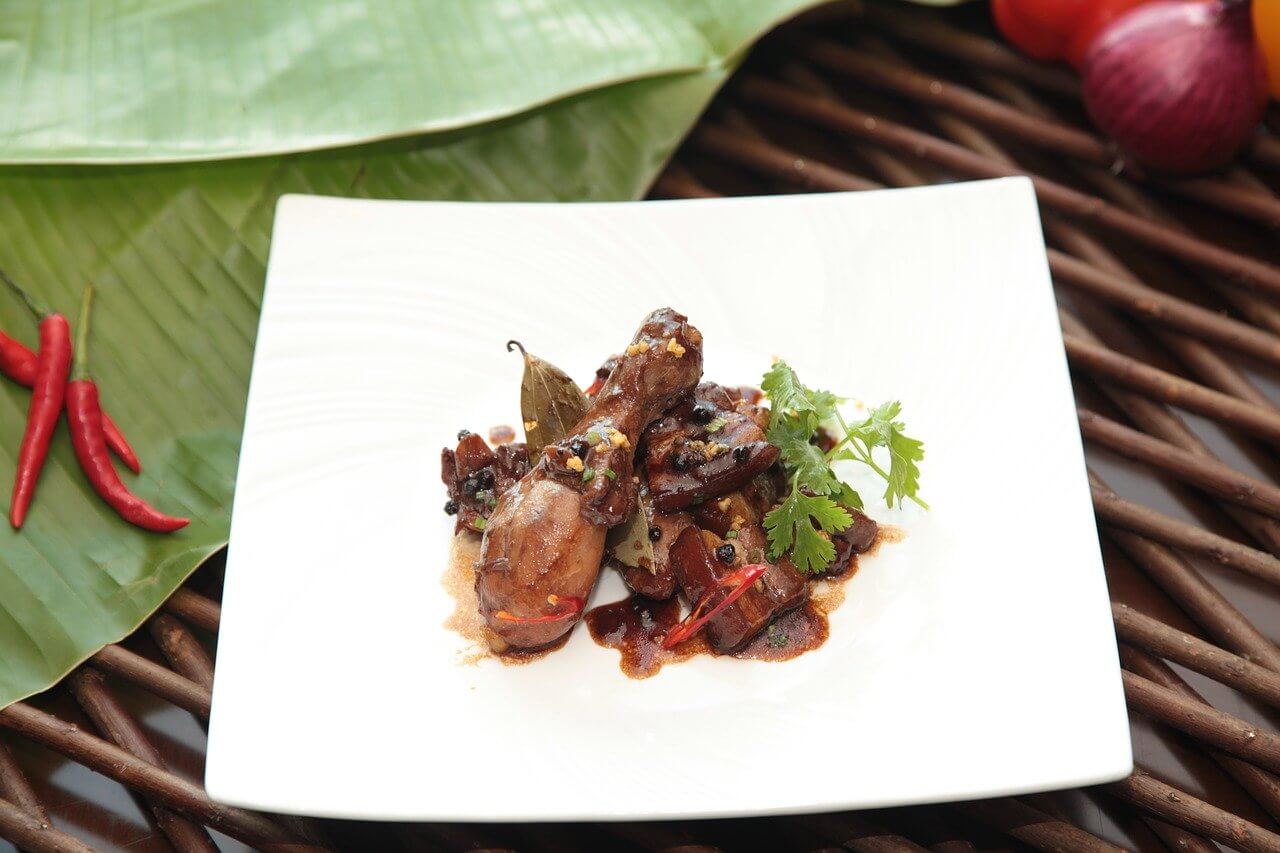
The food in the Philippines may not have a great reputation internationally…
But we’re not sure why – it’s really good!
Taking cues from Austronesian traditions, as well as Chinese, Spanish, Indian and American influences, Filipino food doesn’t deserve the bad rap it sometimes gets.
That said, there are some things you can do in order to make your trip delicious – and safe for your stomach.
- Don’t be scared of “local” joints. Called carinderias, these may look unclean, but the food they serve up could be very tasty. A good rule of thumb is to go somewhere that is heaving with locals – chances are it will be good and won’t harm your belly.
- Go easy on it. Your palate, and your stomach, more than likely won’t be used to food in the Philippines. Don’t dig into all the different spices straight away, not until you’ve acclimatized a little.
- Bring medication. If you have a sensitive stomach, a change in diet such as you may experience in the Philippines can cause upset. It’s a good idea to come well stocked with anti-diarrhoea medication and rehydration sachets.
- Do eat street food. You will see a lot of it and, again, it may look daunting, but if you choose the right place you will be justly rewarded. Go where the locals go.
- Avoid eating things that seem to have been sitting around. Instead, opt for things that can be freshly cooked. Pots of stew, not so much – stir fries, definitely.
- Don’t rely on your hotel’s buffet. It may seem like the safe option, but many people actually get sick from the buffet at the hotel. Venture out and try something new.
- Wash your hands or use hand sanitizer. This is a must! It’s simple, but it’s easy to forget.
There are many different foods you can try in the Philippines: Peanut sauce galore in kare-kare, the classic adobo, lechon (suckling pig)…
Don’t worry: if you feel overwhelmed, a food tour would be a great place to start!
Can you drink the water in the Philippines?
It is not a good idea to drink the tapwater in the Philippines. Not very well treated or purified, it can often lead to you getting ill.
It is ok to have a few ice cubes in your drink, and it is also fine to brush your teeth with.
One exception is El Nido – here you should avoid the tapwater altogether.
There are water refilling stations, however, and – as bottled water doesn’t come cheaply – it’s a good idea to save the planet and bring your own refillable water bottle.
Is the Philippines safe to live?
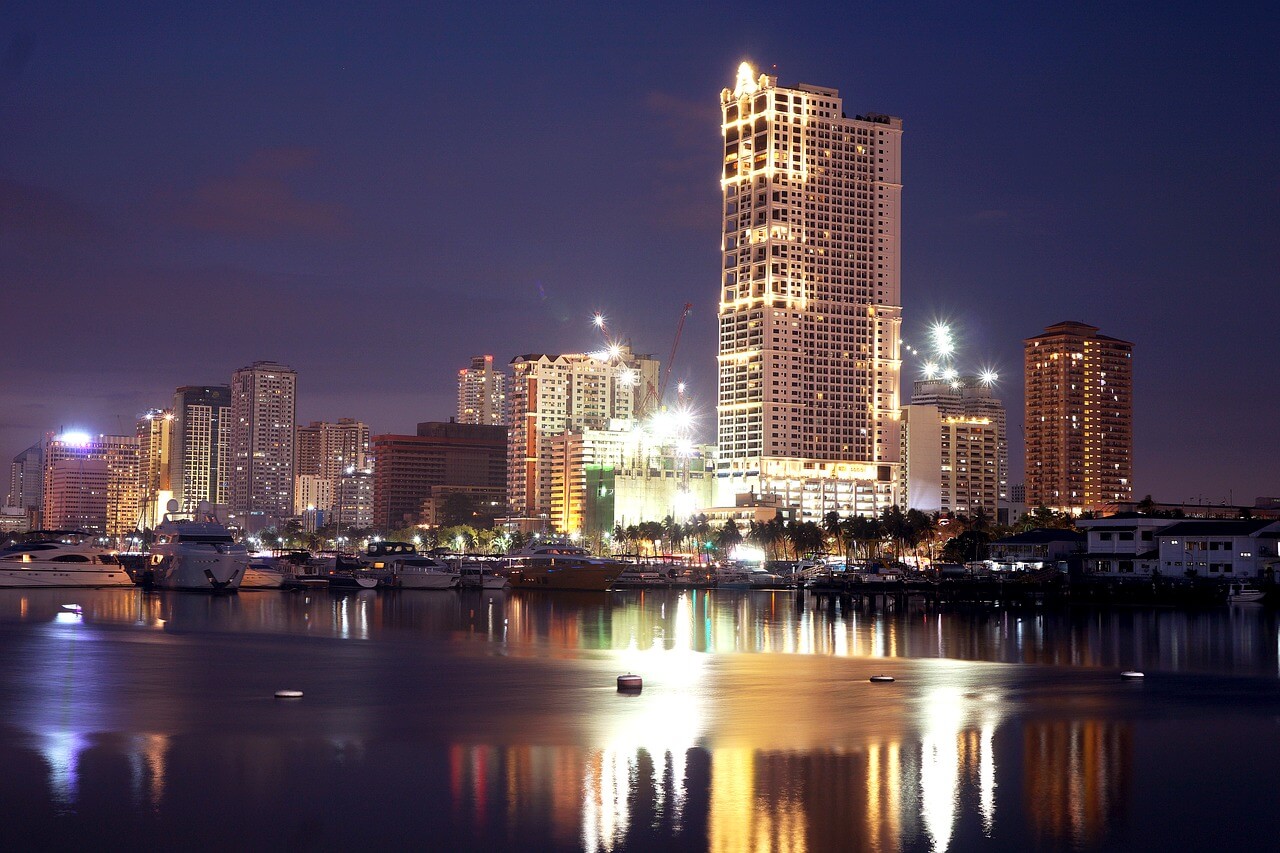
Living in the Philippines will be very different to where you live now. It is safe enough, as many expats do choose to live here, but there are aspects that you will have to get used to.
It is one of the fastest-growing economies in Asia, however, that doesn’t mean that things are always going to run smoothly…
- Transport systems, as we’ve discussed, are not very well developed.
- Infrastructure – such as bridges and the like – can be poorly maintained.
- Power failures and water shortages can frequently affect certain areas of the country.
If you want to be safe from the risk of crime, it is best to base yourself away from the centre of big cities such as Manila and Cebu City. Pickpocketing and break-ins do occur, but everyday life is relatively safe – as long as you know the area you are living in and practice safety precautions.
Filipinos are very friendly and hospitable people, open to outsiders. You shouldn’t have any problem getting to know your neighbours, making new friends and creating a network of people who can help you out if you are ever in need.
A big part of living in the Philippines is the weather and natural environment. Typhoons can wreak havoc on the east coast, with people who live in older houses – or near rivers and the sea – more under threat.
If you have experienced a typhoon, you will know that they are scary.
The Philippines is also in the “Ring of Fire.” That means volcanic eruptions, earthquakes and tsunamis can (and do) occur. The key is to know what to do if anyone of these hits – having an emergency bag packed and ready to go is a good idea.
You should research the sort of place you want to live, checking expat guides online and connecting with expat groups to ask important questions and your potential move.
How is healthcare in the Philippines?
Like many things in the Philippines, the quality of healthcare varies greatly depending on where you are in the country.
In major cities, you will have no problem getting access to modern hospitals and competent healthcare.
In fact – Manila and Cebu City are actually medical tourism destinations!
If you have an emergency, dial 911. Ambulance services differ, however. Note that if you do this you will be taken to public, not private, facility.
Other areas of the Philippines do not have the same level of medical care on offer. Rural areas are severely lacking in modern medical care.
Local people on remote islands, for example, will often rely on folk medicine if they get sick or injured.
There may be “normal” clinics in these sorts of areas, but these possibly won’t meet the quality of care that is provided in your home country.
Even popular tourist spots outside of big cities lack basic medical provisions – that means no access to hospitals or emergency care.
It is very important you have medical travel insurance that covers you for private hospital treatment, as well as transport.
You will be able to find (often 24-hour) pharmacies in the centres of big towns and cities. Most hospitals will also have a pharmacy attached, too. They are staffed by accredited pharmacists who can offer advice and sell over the counter medicine.
If you do need healthcare in the Philippines, the best idea is to ask for a recommended facility at your accommodation.
Helpful Philippines Travel Phrases
Most Filipinos speak English quite well in the cities and touristy areas; however, it’s nice to know a few Tagalog phrases and connect with the people!
Hello – Hi!
Goodbye – Paálam
How Are You? – Kumusta ka?
My Name Is… – Ang pangalan ko ay…
How much is this? – Magkano to?
Where’s the toilet? – Nasaan ang banyo?
Stop! – Para!
No plastic bag – Walang plastic bag
No straw please – Pakiusap walang straw
No plastic cutlery please – Pakiusap bawal ang plastik na kubyertos
Do you speak English? – Sabihin ang sa English?
I don’t understand! – Hindi ko naiintindihan
Thank You – Salamat
Final thoughts on the safety of the Philippines

If you were thinking that the Philippines were completely safe and an island paradise, that is not the case. At the same time, if you were worried the Philippines was a dangerous world of thievery and volcanoes, you are also mistaken!
The Philippines is a cool place to visit, but it’s not a theme park and you should take care wherever you go.
Whatever you end up doing – don’t forget travel insurance!
Disclaimer: Safety conditions change all over the world on a daily basis. We do our best to advise but this info may already be out of date. Do your own research. Enjoy your travels! Some of the links in this post are affiliate links which means we earn a small commission if you purchase your insurance through this page. This costs you nothing extra and helps us keep the site going.
Need More Inspiration?
- 15 Amazing Sunset Spots In Asia According To Travel Bloggers
- The 33 Most Instagrammable Places In The Philippines
- 5 Single Traveller Destinations In The Philippines








